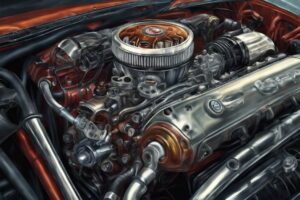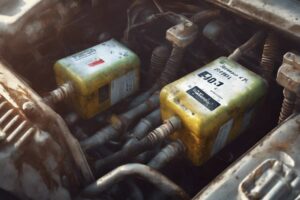To close your car hood correctly: lower it slowly until latch hooks on, then press down firmly. Dropping from 300mm height engages latch securely, so avoid pressing directly on hood to prevent dents.
Align hood carefully with fenders to prevent misalignment issues and guarantee vehicle aesthetics. Handle lightweight aluminum hoods gently to avoid damage. Steer clear of fingertip pressure, as it can dent the hood.
Double-check closure by pulling gently, listening for a distinct click, and inspecting alignment. These tips help prevent damage and guarantee proper hood closure.
Key Points
- Slowly lower hood until latch hooks on for secure closure.
- Avoid excessive fingertip pressure to prevent dents.
- Verify hood is fully latched with a gentle pull.
- Align hood with fenders to avoid misalignment issues.
- Handle lightweight aluminum hoods with care to prevent damage.
Proper Technique for Latching Hood

To properly latch your car hood, slowly lower it until the latch hooks on and press down to lock securely. This guarantees a secure closure and prevents any potential safety hazards while driving.
Dropping the hood from a height of 300mm or less effectively engages the hood latch mechanism, providing a sturdy lock. It’s important to avoid pressing on the hood to prevent any dents, especially on soft automotive sheet metal.
However, if your vehicle is equipped with hood pins and alignment becomes an issue, dropping the hood from about 1 foot can be considered.
By following the manufacturer’s recommended method for hood closure, you can help prevent any damage to the hood latch and ensure a proper and secure fit.
Aligning Hood With Fenders
Properly aligning your car hood with the fenders is essential for ensuring a seamless fit and avoiding potential issues such as gaps or misalignment.
When your hood is correctly aligned, it not only enhances the overall appearance of your vehicle but also plays an important role in paint protection and rust prevention.
Gaps or misalignment can lead to water leakage, wind noise, and even potential damage to the hood or fenders over time.
To align your hood with the fenders, start by visually inspecting the alignment along the edges. Look for even spacing and consistent gaps on both sides. If you notice any discrepancies, adjustments may be needed.
These adjustments often involve tweaking the hood hinges or latch to achieve the correct alignment.
If aligning the hood seems challenging or if you’re unsure about making the adjustments yourself, it’s best to seek professional assistance.
A professional can ensure precise alignment, preventing any future issues and maintaining your car’s structural integrity.
Handling Lightweight Aluminum Hoods

When handling lightweight aluminum hoods, exercise care to prevent dents or damage from occurring.
Aluminum hoods, common in modern vehicles for enhanced fuel efficiency, are more susceptible to dents and dings than traditional steel hoods.
To maintain the appearance and integrity of aluminum hoods, it’s important to apply gentle pressure when closing them. Avoid using excessive force, as this can lead to denting the hood surface.
Furthermore, be mindful of heavy items or leaning on the hood, as these actions can cause deformation.
Following the manufacturer’s recommendations for closing aluminum hoods can help prevent dents and ensure the hood retains its original shape.
By handling lightweight aluminum hoods with care and using gentle pressure, you can maintain their appearance and prevent damage, ultimately prolonging the life of your vehicle’s hood.
Avoiding Fingertip Pressure
Using excessive fingertip pressure on light aluminum hoods can result in dents and damage.
To prevent deformation, it’s important to avoid pressing down on the hood latch with just your fingertips. Instead, opt for a more secure closure by applying light, even pressure on the hood latch.
This gentle approach guarantees that the hood closes properly without causing any dents.
For dent prevention and secure closure, consider using the palm technique. By using the palm of your hand, you can distribute pressure evenly across the latch, reducing the risk of damaging the hood.
Proper closure technique involves applying gentle force on the latch, avoiding any excessive pressure that could lead to hood damage.
How Can Properly Closing Your Car Hood Prevent Stuck Car Windows?
Properly closing your car hood can prevent stuck car windows. When the hood is not closed securely, it can cause vibrations that can affect the functionality of the windows. To avoid this issue, ensuring a tight seal on the hood is essential. For effective car window solutions, always double-check your hood closure.
How Can Properly Closing Your Car Hood Prevent Issues with the Transmission?
Properly closing your car hood is essential to prevent issues with the transmission. If the hood is not secure, it can cause vibrations that may lead to a misalignment in the transmission. This can result in transmission problems such as troubleshooting car won’t reverse. Always ensure your hood is securely closed to avoid potential transmission issues.
Double-Checking Hood Closure

After closing the car hood, verify that it’s fully latched by giving it a gentle pull. This step is important to make sure that the hood is securely fastened in place.
Also, take a moment to inspect the hood alignment, looking for any visible gaps between the hood and fenders. Proper alignment indicates that the hood is correctly closed and provides an extra layer of safety.
When double-checking the hood closure, listen for a distinct click sound, which signifies that the hood has latched into place securely.
This auditory confirmation adds to the visual and tactile checks you perform.
It’s also advisable to check the hood release lever inside the cabin to ensure it’s fully engaged. This precautionary measure prevents accidental hood opening while driving.
Preventing Safety Hazards and Damage
To prevent safety hazards and damage, always handle your car hood with care and follow proper closing procedures as outlined in the manual.
Avoid shortcuts and guarantee security by gently lowering the hood instead of dropping it from a height. Dropping the hood can potentially damage the hood locking mechanism, leading to safety risks and costly repairs.
Also, pressing down on the hood may cause dents, especially if done repeatedly.
To prevent accidents and ensure longevity, be cautious around the soft areas near the latch, as they’re prone to denting if excessive force is applied.
Adhering to the recommended closing method from the manual can prevent unintended damage and maintain the structural integrity of your vehicle.
Users have reported dents on the hood due to improper closing techniques, highlighting the importance of handling your car hood with care to avoid unnecessary repairs and safety hazards.
As an Amazon Associate we earn from qualifying purchases.










